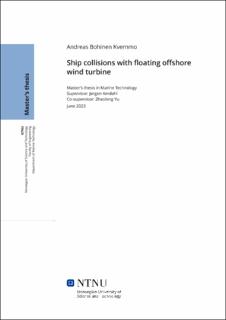| dc.description.abstract | Offshore vind er en fornybar energikilde som får mye fokus. Blant fordelene med offshore vind-energi er for eksempel bedre vind-forhold og større muligheter til å øke turbinstørrelsen sammenlignet med landbaserte turbiner. I tillegg, om man bruker flytende konstruksjoner, vil turbinene kunne plasseres steder hvor man ikke
trenger å ta hensyn til havdybde og plassrestriksjoner i like stor grad. Dette kan riktignok føre til større behov for vedlikehold og reparasjonsbesøk til turbinene. Disse vedlikeholdsfartøyene kan måtte økes i størrelse og forholdene rundt turbinene kan være tøffere. Konsekvensen av kollisjoner kan variere fra små skader på konstruksjonen, til at turbinen kollapser, noe som kan ha fatale konsekvenser om tårnet faller mot fartøy og mannskap.
Derfor har klasseselskap som DNV og Bureau Veritas fastsatt standarder for design av offshore vindturbiner, for å minimere risikoen ved kollisjoner. Disse standardene inneholder regler og restriksjoner om design mot både uventede of mer forventede ulykker. Disse reguleringene, i tillegg til teori angående energiopptak, kraft-deformasjons forholdet, og knekning har blitt studert.
For å vurdere ulike metoder for å anslå resistansen mot bulking av sylindere samt reststyrke i allerede skadde sylindere, har programmet LS-DYNA blitt brukt for å simulere kollisjoner. Modeller for både tårnet og de ulike delene av skipet har blitt brukt til simuleringene.
Først ble det utført en mesh konvergens-studie for å bestemme forskjeller som kan oppstå ved forskjellige mesh-størrelser. Studien viste at det var små forskjeller for det relevante resultatområdet for de valgte størrelsene. Så ble kollisjonssimuleringer kjørt for både bulb, bakk, side og akterhjørnet for å beregne kraft-deformasjonskurver. For skipet stemmer resultatene ganske godt overens med de allerede anbefalte kurvene. For tårnet er det større forskjeller. Der er de anbefalte metodene ofte konservative og undervurderer tårnets resistanse mot bulking. Til slutt ble en reststyrke-analyse gjort, for å vurdere effekten bulker har på tårnets evne til å etterkomme kravene til styrke. Igjen er det forskjeller på resultatene og anbefalte metoder. I dette tilfellet er ikke metodene konservative nok, og i følge resultatene i denne analysen vil bulker i tårnet senke reststyrken betydelig mer enn forventet. De tilsier at bare små bulker er nok til at tårnet ikke etterkommer styrkekriteriene. | |
| dc.description.abstract | Offshore wind is a renewable energy source that is receiving a lot of focus and attention. Among the benefits of offshore wind energy is improved wind conditions that, along with the possibility of increasing the size of the turbines, give a larger energy potential than onshore wind. Moreover, introducing floating substructures means less sensitivity to water depth and seabed conditions and less strict space constraints. This may, however, lead to higher needs for maintenance and service visits to the turbines. The vessels may need an increase in size, and the conditions may be harsher. The consequences of collisions can range from minor structural damages to the collapse of the turbine, which in turn could endanger the vessel crew, should the tower collapse towards or onto the vessel deck.
Therefore, classification societies such as DNV and Bureau Veritas have created standards for the design of offshore turbines to ensure that the risk of catastrophic consequences is limited. These standards include rules and regulations regarding design against both accidental and functional impact loads. These standards, in addition to the theory behind collision mechanics, regarding the dissipation of energy, the force-deformation relationship, and buckling theory, have been investigated.
To evaluate proposed analytical models for the assessment of both denting resistance of tubular members and the residual strength of damaged tubulars, the non-linear finite element software LS-DYNA has been used to simulate collisions. Models of both the tower and several parts of a modern supply vessel have been used in order to simulate and evaluate the damage and energy dissipation in the collision.
Firstly, a mesh convergence study is performed to evaluate the inaccuracies that can arise with different mesh sizes. The results show little deviation for the chosen mesh sizes. Secondly, collision simulations between the tower section and the bulb, forecastle, side, and stern corner are performed to evaluate the impact forces and the deformation of the structures. The results show that for the vessel, the force-deformation relationship agrees quite well with what is expected from proposed analytical models. As for the tower, there is more deviance from the expected results, as they are generally too conservative and underestimate the resistance in the tower. Finally, residual strength analyses are performed in order to evaluate the effects of indentation on the bending moment capacity. The results again differ from proposed analytical models. However, in this case, the models are not conservative enough in comparison to the results obtained in this thesis, and the effects of indentations are far bigger than anticipated. They show that only small indentations will seriously affect the towers ability to comply with ULS criteria. | |
